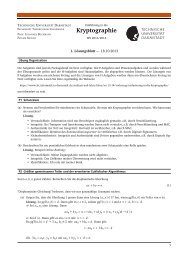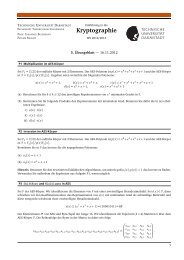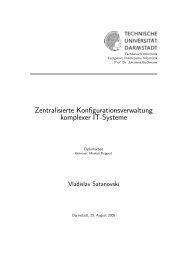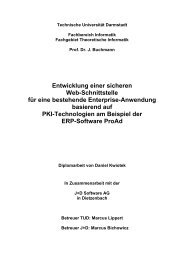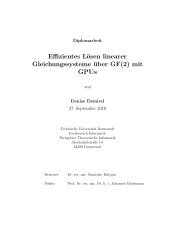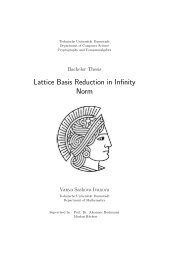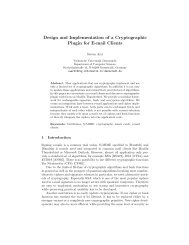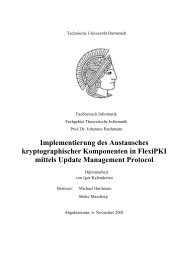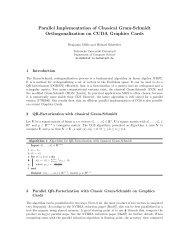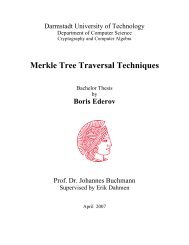An efficient mobile PACE implementation - CDC
An efficient mobile PACE implementation - CDC
An efficient mobile PACE implementation - CDC
Create successful ePaper yourself
Turn your PDF publications into a flip-book with our unique Google optimized e-Paper software.
parameter w parameter v complexity<br />
evaluation<br />
complexity<br />
incl.<br />
precomp.<br />
#precomp.<br />
points<br />
4 1 64A + 63D 71A+255D 15<br />
4 2 64A + 31D 78A+255D 30<br />
5 1 51A + 50D 66A+255D 31<br />
5 2 51A + 25D 81A+255D 62<br />
Table 4: Fixed point multiplication with off-line precomputation<br />
according to Lim and Lee in terms of expected point additions<br />
(A) and doublings (D). The parameters w and v are<br />
chosen to obtain a good trade off between total complexity and<br />
complexity in the evaluation phase for 256-bit curves.<br />
algorithm complexity formula #precomp. points<br />
left-to-right binary<br />
Windowing (2 w +<br />
Windowing NAF ( 2w+1<br />
3<br />
λ(e)<br />
2 A λ(e)<br />
� �<br />
λ(e)<br />
w − 3)A<br />
+<br />
� �<br />
λ(e)+1<br />
w − 2)A<br />
Lim-Lee precomp:<br />
v(2 w−1 −1)A+(λ(e)− λ(e)<br />
wv )D<br />
main: λ(e) λ(e)<br />
w A + ( wv − 1)D<br />
� �<br />
λ(e)<br />
w<br />
� �<br />
λ(e)+1<br />
w<br />
(2 w − 1) · v<br />
Table 5: Complexity evaluation formulas of algorithms with<br />
off-line precomputation [12, 13]<br />
same length and to process them parallelly as different exponents<br />
comparable to multiple point multiplication with shorter exponents.<br />
<strong>An</strong> additional parameter v specifies how the different exponents are<br />
further partitioned and can also be seen as the number of lookup<br />
tables containing the precomputed points [12].<br />
In cases with no off-line precomputation the method by Lim and<br />
Lee can nearly compete with the window NAF methods. In cases<br />
with off-line precomputation the method by Lim and Lee performs<br />
significantly better than the window NAF methods.<br />
3.2 Review of Basic Elliptic Curve Multiple<br />
Point Multiplication Techniques<br />
There are several methods available [12] which evaluate product<br />
sums k ·P +l·Q much more <strong>efficient</strong> than carrying out the individual<br />
multiplications sequentially and add the results. The complexity<br />
and the number of stored points for different approaches can be<br />
seen in Table 6. The respective complexity formulas are given in<br />
Table 7.<br />
While in the first three algorithms addition and doubling operations<br />
are done simultaneously, interleaving only does the doubling<br />
simultaneously. In our case the latter has some advantages. Firstly,<br />
the precomputed points rely on the points P and Q only. This<br />
allows storing precomputed points for further use. Secondly, the<br />
method allows for exponents with different lengths. Both is useful<br />
in our <strong>PACE</strong> scenario.<br />
algorithm parameter choices complexity #precomp.<br />
points<br />
Simultaneous mult. point w = 2 128A + 256D 15<br />
Simultaneous slid. window w = 2 118A + 256D 12<br />
Simultaneous Joint Sparse<br />
Form (JSF)<br />
w-NAF Interleaving<br />
λ(e1) = λ(e2) = 256<br />
w-NAF Interleaving<br />
λ(e1) = 256, λ(e2) = 128<br />
− 129A + 255D 3<br />
w1 = w2 = 5 99A + 258D 16<br />
w1 = w2 = 5 78A + 258D 16<br />
Table 6: Multiple point multiplication in terms of expected<br />
point additions (A) and doublings (D). The window parameters<br />
w are chosen to be optimal for 256-bit curves.<br />
algorithm complexity formula stored points<br />
Simultaneous mult. point (3·2 2(w−1) −2 w−1 −1+<br />
2 2w−1<br />
2 2w<br />
� λ(e)<br />
w<br />
�<br />
− 1)A +<br />
(2 2(w−1) − 2 w−1 � �<br />
+<br />
λ(e)<br />
( w − 1)w)D<br />
Simultaneous slid. window (3·2 2(w−1) −2 w−1 −1+<br />
λ(e)<br />
w+1/3 )A + (22(w−1) −<br />
2 w−1 � �<br />
λ(e)<br />
+( w −1)w)D<br />
Simultaneous (JSF) (1+ λ(e)<br />
2 )A+(λ(e)−1)D 3<br />
w-NAF Interleaving ( �<br />
j (2wj −2 − 1) +<br />
� λ(ej )<br />
j wj +1 )A +<br />
(|j : wj > 2| +<br />
maxjλ(ej))D<br />
2 2w − 1<br />
2 2w − 2 2(w−1)<br />
�<br />
j (2w j −2 )<br />
Table 7: Complexity evaluation formulas of multiple point multiplication<br />
algorithms [12]<br />
4. OPTIMIZED <strong>PACE</strong><br />
In this section we discuss the most promising optimizations for a<br />
<strong>PACE</strong> <strong>implementation</strong> on cell phones. The stated amounts of ADD<br />
and DBL are derived from the findings from Section 3 and express<br />
the average case. The proposed optimizations all lead to very similar<br />
theoretic execution times. Which one is the best in practice<br />
seems to depend on the actual hardware and the respective environmental<br />
circumstances. As we have seen in Section 3, storage space<br />
for points is not an issue on modern <strong>mobile</strong> devices, and is therefore<br />
not considered here. Likewise the time to load these points can<br />
be assumed to be negligible.<br />
Following the <strong>PACE</strong> specification (cf. Figure 1) the PCD<br />
conducts the EC computations shown in Equations (1) to (5).<br />
Counting the PCD’s EC computations in this notation leads to a<br />
total of 1 ADD and 5 MULT.<br />
X = x · G (1)<br />
H = x · Y (2)<br />
G ′ = s · G + H (3)<br />
�P KPCD = � SKPCD · G ′<br />
(4)<br />
K = � SKPCD · � P KPICC (5)





